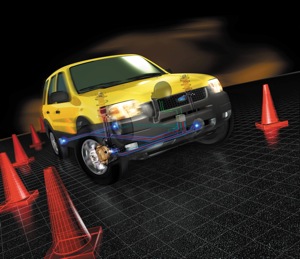For 2012, every vehicle under 10,000 pounds sold is equipped with electronic stability control (ESC) as mandated by NHTSA.
In 2007, 45% of vehicles sold were equipped with ESC, meaning more than half of the late-model vehicles showing up for service at your location may be equipped with ESC. This is an ideal sales and education opportunity for tire dealers to boost sales of ride control products and tires. 
An ESC system cannot rewrite the laws of physics. It cannot mask problems with the vehicle like worn out shocks, struts or tires. When shocks or struts degrade, they lose their ability to control the yaw and pitch of a vehicle. As a vehicle pitches and yaws, weight transfers and the contact patch of the tire changes.
If a driver is making a sudden lane change to the right and performs a panic stop, the weight of vehicle is transferred to the left front wheel. If that corner of the vehicle has a weak shock or strut, the suspension could rapidly compress. As a result, the right rear tire has less weight and less traction due to the smaller contact patch, as does the left rear tire to a lesser extent.
This means that the vehicle could go from an understeer condition to a “snap” oversteer very quickly. In this situation, the ESC system might apply the inner rear wheel to counter understeer, and then deploy at the outer front brake to counter the snap oversteer.
ESC does not improve a vehicle’s cornering performance in this scenario, it just helps to minimize the loss of control. But, properly functioning ride control components and tires can improve the performance of the ESC system.
All shocks and struts wear. Under normal conditions on a smooth road, shocks stroke on average 1,750 times for every mile traveled. On every stroke, the valves, seals and oil degrade a little bit. When they are worn, they lose the ability to dampen the movement of the body and wheels. When a vehicle movement is not dampened, it can compromise the tire’s contact patch and minimize the ESC’s effectiveness.
Evolution
ESC systems tie together numerous sensors and computers that calculate where the driver wants to go and what the vehicle is actually doing. With this information, it decides what corrective actions should be made with the brake system to keep the vehicle under control. And while corrections are being carried out, it also is sensing the effectiveness of the corrections – and making more corrections as needed.
And all of this happens at light speed.
High-speed computer networks and processors make this possible. All 2008 and newer light vehicles have a Class 3 Controller Area Network (CAN) bus system operating at a high-baud (speed) rate. These CAN bus systems simplify vehicle wiring and allow sensors to talk to a wide variety of systems and components. One wheel speed sensor may share its information with the ESC system, cruise control and even the car stereo.
ESC ties together sensors for wheel speed, yaw/pitch and driver controls into a network with a module that controls the braking system. These sensors are very sophisticated and intelligent. For example, the steering angle sensor measures a lot more than just the angle of the front wheels; it also measures the speed of the driver’s correction on the steering wheel and some can even sense the amount of force being applied. Yaw and lateral acceleration modules measure the rotational acceleration and how the vehicle is pitching.
The computer processor in stability control systems takes the information and decides what is happening and what corrections should be made. After a correction is made, it measures the effectiveness of the correction and decides if any further action should be taken. This is done in real time with a very fast network and a very fast processor.
When a system is measuring the effectiveness of a correction, it is indirectly measuring the effectiveness of the tire’s contact patch and the health of the ride control components. If a strut cannot dampen and control the movement of the suspension and body, the contact patch of the tire is minimized.
What ESC Can’t Do
ESC does not improve a vehicle’s cornering performance. Instead, it helps to minimize the loss of control. During an emergency lane change, the ESC system cannot change the compression and rebound of the ride control components. All the ESC can do is react to the overall vehicle dynamics.
You will never see a check engine or malfunction indicator light that will be set due to the condition of non-active shocks or struts. ESC cannot directly, physically measure the health of the shocks/struts or the tires and compare it to a set of parameter IDs (PIDs) in the ESC computer.
The system operates on a feedback loop. If a correction by the brake system is not effective due to worn components responsible for controlling the tire’s contact patch, it will have to carry out more corrections.
Some computer programmers use the saying, “garbage in, garbage out” or some more colorful derivative. This saying could be applied to worn shocks and struts on ESC-equipped vehicles. Customers need to be made aware of not only how new shocks and struts can improve the ride, but they need to be aware how they are an integral part of the ESC safety system.













